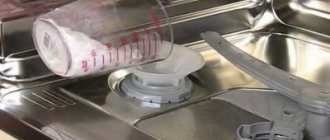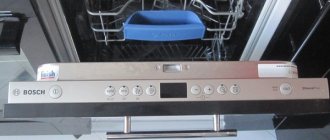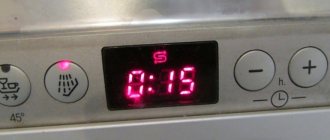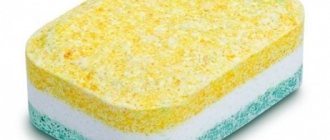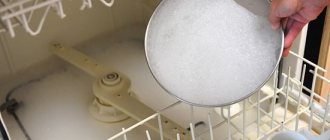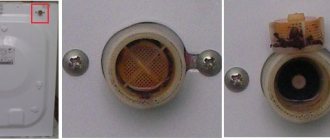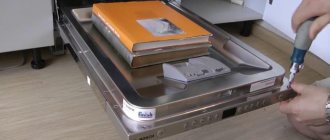“There is water in the dishwasher!” - RemBytTech managers hear almost every day. We always clarify the details. There are two options:
- The dishwasher has completed the cycle, the dishes are clean and dry. But there was water left at the bottom of the equipment after washing.
- The dishwasher has stopped running with water, but the program is not finished. The dishes are wet and perhaps even dirty.
Whatever your case, in this article we will tell you why this could happen, what you can do yourself, and when you need to call a specialist.
How the device works
Water is supplied through the inlet valve - in the dishwasher it is a single type - then it fills the tank to a certain level and is pumped into the rocker arms by a recirculating pump.
Then it flows under pressure, creating circular movements of the rocker, due to which food debris is removed. To thoroughly wash dishes, water is heated using a special element to the maximum temperature set for this model, then it is collected at the bottom of the machine, filtered and supplied for a new cycle of operation.
The water level in the tank is monitored by a special sensor or pressure switch; the solenoid valve is responsible for various additives to the water, softening salt, for example. Powder and rinse aid are added to the working chamber as needed from the dispenser, which is located on the machine door.
The pressure on the sensor comes from two places:
- While collecting water in the main tank.
- Level control in the pan when draining dirty water.
The central board uses the information received in various ways; it is here that signals about any faults that arise are received.
How to replace the water intake valve?
If the dishwasher is turned on and draws water on its own, diagnose the valve. In different PMM models, its location varies. It can be located on the side, back or bottom of the case. The easiest way is to trace where the inlet hose is connected. Behind the hose is a filter, and behind that is a valve.
To carry out diagnostics, disconnect the dishwasher from the mains and close the inlet valve. Disconnect the fill hose and remove the filter using pliers. If necessary, remove the panel.
As soon as the part is in front of you, set the multimeter toggle switch to resistance measurement mode. Disconnect the wiring. Ring the valve coil. Indicators from 500 to 1500 Ohms are considered normal. If the readings remain at zero, the coil is broken. In this case, only replacing the element will help.
- Remove the hose from the valve.
- Unscrew the fastening.
- Install the new part.
To protect yourself and your equipment from leaks, install Aquastop protection if it is not provided by the manufacturer. The inlet hose is protected by a special valve. And in the tray of the machine there is a float sensor.
What to do if your Bosch dishwasher does not drain water
If your dishwasher stopped before the end of the cycle or did not run it properly, then, depending on the coding on the screen, you can determine the cause of the malfunction. If the words “END”, E24, E25 are displayed on the screen or a faucet is displayed, this means that your Bosch dishwasher is not draining water.
Dishwasher drain system problems
If a Bosch dishwasher does not drain water, this is just a sign of a malfunction, including:
- the drainage system is clogged;
- the siphon or other drainage element is clogged;
- the drain pump has failed;
- control failure occurred.
All these breakdowns are complex, but can be corrected.
My Bosch dishwasher won't drain, what can I do?
You need to start your inspection from the drainage system, that is, from the point where the drain hose is connected. If a clog is found there, then the problem is not in the dishwasher. It is necessary to clean this particular part of the drain system. If not, then you should inspect the equipment itself.
First you need to inspect the filter. It unscrews clockwise. It is removed along with the mesh. It needs to be washed and cleaned with a brush. For this you need to use water, preferably running water. Next, you need to remove the remaining water from the dishwasher manually.
Then the drain pump impeller is checked. To do this, you need to open the lid. It can be screwed on or snapped. It depends on the model. After opening the lid, you need to get rid of all foreign things that could get inside. Check that nothing is blocking the rotation of the impeller.
We put all the parts in place and check the result. If it is missing, this may be due to a faulty drain pump. To fix it, you need to disassemble the machine; to perform such repairs, it is better to contact a specialist.
Enabling forced drain
This operation can only be carried out after checking and cleaning the drain system. To force the machine to forcefully drain water, it is necessary to carry out a number of manipulations, which depend on the model of the machine.
Older Bosch series may have a ratchet switch installed. To open the drain valve, simply rotate it clockwise. In models srv, sgv, etc. you need to reset the programs and close the door. The valve will automatically open. In order to start forced draining for smv, spv, etc. machines, you just need to hold the start button for about 3 seconds.
Removing blockages
In each of the above cases, in order to restore the functionality of the equipment, it is necessary to perform certain manipulations. We'll tell you how to do this further.
Cleaning the filter and checking the pump
In a dishwasher, the filter consists of two elements joined together. This design is located at the bottom of the working chamber. In most models, the main filter is framed by a filter mesh, which is also a filter that does not allow food waste to pass through.
The filter and filter mesh can be removed for cleaning
The inner “glass” is made of coarse mesh and is a coarse filter element. When water passes through this part, it hits the surface of an outer metal mesh with small cells - a fine filter element that finally cleans the liquid from food debris.
Coarse and fine filter elements
To clean the filters, follow these steps:
- Remove the dish baskets from the PMM.
- Unscrew the filter cap, which is located in the bottom of the chamber, next to the sprayer.
- Remove the two dirty filter cups from the niche.
- Rinse both filters thoroughly with running water. If necessary, use a toothbrush and any dishwashing detergent.
- Open the cover, which is located under the filters and gives access to the pump impeller. Carefully check that the impeller rotates freely. If something is slowing it down, you should remove the blockage using tweezers.
- After cleaning, return all parts to their places.
This is what a pump with an impeller looks like in many Bosch and Siemens PMM models
Sewer cleaning
In this case, the pump does not have time to remove all the water during its operation, since the sewer system is clogged. It is easy to localize the problem - disconnect the drainage hose from the sewer.
If dirty liquid leaks from it, try cleaning the part yourself, for which:
- Pour boiling water with dissolved pipeline cleaner into the drainage hole (it is possible that only the siphon is clogged).
- If there is no result, try cleaning the pipe with a steel cable (if you have one) or call a plumber.
Plumbing cable for cleaning sewer pipes
Checking the drain hose
It happens that cleaning the filters and checking the sewage system does not lead to the desired result - the water is still not pumped out. This may mean that the drain hose is clogged or pinched.
First, check to see if the hose is pinched by furniture or other objects. Feel it along its entire length (this manipulation helps remove the blockage). Once you are sure the hose is clean and not kinked, turn on the dishwasher to check the drain system. You can disconnect the drainage pipe from the sewer and place it in a large container to make sure it is working.
Disconnecting the drain hose from the sewer
What to do if the dishwasher does not fill with water
It often happens that the dishwasher stops drawing water, and the washing process is postponed for an unknown time. This problem needs to be solved progressively:
- First you need to check the basics: is there water in the tap?
- Then, how tightly the machine door is closed
- Is the shut-off valve on the water pipe closed?
- Is the hose through which water enters the dishwasher pinched?
Eliminating these minor problems may or may not bring a positive result, in which case it will mean that the problem lies in something completely different. For example, the inlet valve filter may be clogged and to clean it you need to unscrew the hose through which water is supplied and find the filter mesh. Then it needs to be thoroughly cleaned and rinsed.
In addition to the problems listed above, more serious ones may also arise:
- Door lock system failure
- Intake valve failure
- Malfunction of the pressure switch - a device for measuring water pressure
- Failure of the Aquastop leakage system
- Malfunction of the control module
To “treat” such problems, you need to involve specialists.
Instructions on how to drain the water if necessary
If you are waiting for a technician, we recommend that you forcefully drain the water so as not to bother with it and waste extra time. This process depends on your make and model. Older units have a special ratchet switch that controls the drainage. In newer models, you cannot simply open the hopper door - you need to reset the locking program. Press the start button for a few seconds and the door should open. Then the sequence is like this:
- Disconnect the drainage hose from the device and drain directly into a deep container. You can help by clicking on the “Drain” mode. The path is under slight pressure, but the water may spill out a little;
- We also drain the liquid from the water supply hose;
- The water in the machine can be scooped out or drained by carefully tilting the device over the container.
The water does not drain, what could be the reason for this?
There may be several reasons why there is water in the dishwasher. In the first case, we may be talking about a blockage or a kink in the drain hose. You can fix this yourself. But other reasons may be more complex in nature, which is associated with malfunctions of individual elements and systems of the dishwasher. In this case, you simply cannot do without the help of professional craftsmen, since attempts at self-repair can lead to more serious problems.
The machine may not drain completely for the following reasons:
The drain hose in the device is kinked. When the hose connecting the dishwasher to the sewer is pinched or bent, then the water simply has nowhere to escape from the equipment. In such a situation, you need to correct the hose, and then turn on the unit and try to start it again. The filter is clogged. Almost every dishwasher manufacturer strongly recommends rinsing all cutlery to remove food particles before placing it directly into the appliance. However, not everyone follows this rule, thereby causing the filter to become clogged with food particles and other debris. This part is located at the very bottom of the device - it should be carefully removed and cleaned of any blockage that has appeared. After completing this simple procedure, the dishwasher will again be able to cope with its main tasks. The drain system is clogged. All the same food residues can lead to the formation of a plug in the drain hose, as well as in the places where it passes into the sewer. You can also clean these elements yourself.
First of all, the drain hose is very carefully disconnected from the sewer system and immersed in a container prepared in advance. Next you need to activate the drain option
When water flows out of the hose under high pressure, the problem lies in the connection between the sewer and the hose. If the dishwasher does not drain the water completely, then you cannot do without cleaning the hose.
The drain pump is clogged. It is because of this reason that the dishwasher most often does not drain the water. If the design features of the equipment make it possible to independently gain access to the pump, then you can clean it yourself. For these purposes, it will need to be dismantled, thoroughly cleaned and then checked for ease of rotation of the internal impeller. This manipulation should be performed using a pencil or other oblong object. This is due to the fact that most blockages consist of broken dishes, which can seriously injure you.
If, after cleaning all the filters and hoses, the dishwasher still does not drain water or does not turn on at all, then the cause of the malfunction may be a more serious breakdown.
For what other reasons might the water not drain?
There are other reasons why your dishwasher won't drain. However, they are quite serious, and only a professional technician can fix them. These include the following:
- The drain pump is broken. In this case, there can only be one way out - replacing the failed element with a new one.
- The pressure switch (water level sensor) has failed. If such an element of the dishwasher breaks down, then the software module will not be able to obtain information about the internal water pressure. In such a situation, it will also be necessary to replace the faulty part, otherwise the equipment will not work correctly, increasing the likelihood of a flood.
Software module failure. It is this element of the dishwasher that is responsible for analyzing the washing cycles and sending appropriate signals to all other equipment components. If such a system fails, then the entire operation of the device leads to various unpleasant situations. If the unit does not drain the water completely, then it may well be that the entire software module is broken.
Each of the listed reasons for incomplete drainage of water requires its own specific solution, which the video will help you learn about in more detail.
Breakdowns requiring repair by a specialist
Previously there were problems that you can fix yourself. But often a breakdown can turn out to be more serious than it seems at first glance, and there is no way to do it without outside help.
Pump faulty
Determining whether the circulation pump is working is quite simple: in operating mode it makes a characteristic mechanical sound similar to a hum. Silence or extraneous noise when pumping out liquid is a sign of a breakdown. If you cleaned the pump, ran it in test mode, and it still doesn’t work, then the problem is not a blockage, but a burnt-out motor. There is nothing left to do but replace the entire module. To do this, you will have to disconnect the part from the wiring and disconnect it from the device - it is better to entrust this to a professional.
The water level sensor is faulty
The water level sensor (or pressure switch) may break down, the control board will not be able to adjust the operation of the pump - as a result, the liquid does not leave the pan. The pressure switch is located under the bottom of the machine and is a plastic box connected to a pressure tube. We recommend entrusting repairs or replacements to a professional.
The electronic “brain” burned out
The electronic module or “brain” controls all dishwasher systems. It may fail if water accidentally gets on it or if there is a power surge, which means the machine will stop and the water will not drain. Its breakdown is a serious problem. We need diagnostics of a complex device, which can only be carried out by a trained service employee. The control unit may have to be reflashed or completely replaced, but this is expensive, and most often, it turns out to be more profitable to buy a new dishwasher.
Other mechanical failures
Incomprehensible noise, rattling and grinding can be eliminated with your own hands only if they are caused by fragments of dishes or other hard debris getting into the system, which can be reached. Check the entire path of water flow from start to drainage, remove all excess and start again. If nothing is found, but the knock remains, call a specialist to your home.
Causes of malfunction
All reasons that may be associated with drainage can be divided into two groups. The first group is associated with all kinds of blockages, and the second suggests a breakdown (malfunction) of some dishwasher unit. We list all the reasons for such a malfunction:
- The drain hose is kinked in some place, so the water does not physically leave the machine. It is enough to straighten it and try to turn on the machine again. Such a trivial problem rarely happens.
- the coarse filter is clogged. Do not neglect the simple rule - before loading, clean the dishes from food residues. Bones, napkins and other debris clog the filter holes, and water will not be able to leave the tank.
- clogged drain areas. Food that has passed through the filter can create a blockage in any part of the drain system, for example, in the pipes, drain hose or pump.
- the pump burned out;
- the pressure switch is faulty;
- The software module is broken.
In Bosch dishwashers from the SRV, SRS or SKF series, in some models the drain problem is detected only after the end of the program. In the middle of the cycle, the machine does not drain the water, but continues to wash dishes only in waste water. But when you open the door, you will see that there is water left in the tank. Some machine models may stop in the middle of the program, and the display will show the word “END” and an indicator in the form of a drawn faucet, which indicates an error during the program.
In Bosch dishwashers from the SMV, SPS or SKS series, if there is a display, fault code E24 will appear, informing about a problem with the drainage. If there is no display in the dishwasher, the lights will light up and a beep will sound and the machine will stop working.
How to prevent the problem from reoccurring?
It is not easy for dishwasher owners to take any preventative actions regarding the drain system.
The only possible procedures may be:
- laying the drain hose in such a way that there is no possibility of fracture or squeezing;
- compliance with the instructions - preliminary cleaning of dishes from food residues before placing them in baskets or trays.
All other components and parts operate automatically, and there is no way to influence them in any way.
How a dishwasher works
Copying the washing process, water enters the dishwasher bypassing the inlet valve. Single knot. Water fills the tank, touching the level of the lower waterproofing of the door, sometimes heats up, and is pumped through a pipe into the rocker arms by a recirculation pump. A rain of jets washes the dishes, the individual holes are directed to create a torque on the rocker. Movement is happening.
Water is collected by the lower part of the compartment, passes through a cascade of coarse and fine filters, is collected by a settling tank, and is re-supplied according to the program. Once completed, the sump pump releases the dirty stream into the sewer.
The progress of the cycle is monitored by a pressure switch, the heating element heats the water if necessary, the solenoid valve adds softening salt according to the readings of the sensor set to the regulator. Powder and other products are poured into the door dispenser and thrown into the working chamber as the need arises.
Let us add that the pressure switch pressure is taken in two places:
- On the side tank, water is stored during the filling period (preheating).
- The level in the settling tank is controlled during descent.
It is clear that the central board is free to use the information in various ways.
Should water remain in a dishwasher that is not working?
In a normally operating dishwasher, a small amount of liquid should remain at the bottom - this helps prevent the rubber seals from drying out.
As the moisture at the bottom of the device evaporates, the condensate moistens its walls, ceiling and, accordingly, the sealing material (it does not dry out and remains elastic).
Attention! The depth of the puddle at the bottom of the dishwasher cannot exceed 1 cm. A significant amount of liquid, as well as food residues, indicate a malfunction of the dishwasher.
What to do: 6 reasons why water does not drain from the dishwasher
Many people use dishwashers. Some use it every day, while others periodically (when a large amount of dishes accumulates after a feast). No matter how often its owners use it, it may break.
If any problems arise with it, you should pay attention to it. It is necessary to determine the reason why the water does not drain from the dishwasher.
The reasons may be different: blockage, complete or partial breakdown of equipment.
There are six common reasons why water remains in the car:
- Problem with the drain hose;
- Clogged filter;
- Drain clogged;
- Pump burnt out;
- Breakdown of the pressure switch;
- Software module failure.
The second reason for water stagnation in the dishwasher is a clogged cleaning filter. Care must be taken to ensure that food residues do not get into the machine in large quantities. Before loading dishes, you should clean them of food particles. Debris can cause the filter to clog. It needs to be cleaned periodically to avoid problems with water stagnation.
The drain can become clogged with food debris (bread, bones) or paper napkins. You need to carefully monitor the cleanliness of the drain and prevent debris from accumulating in it. If the machine is clogged, you can fix the problem yourself or call a technician.
There may be problems with the pump. In this case, the machine may not drain water. In addition, dishes may not be washed properly
To improve the quality of washing, you should pay attention to the operation of the pump. First you need to check the connection of the dishwasher to the outlet and the settings
If the machine does not work/drains water, but is turned on, then the problem is in the pump. It can burn out completely, which means it needs to be replaced.
What preventative measures should be taken?
Prevention methods:
the use of high-quality dishwashing detergents that do not contain chemicals that damage the internal structure of the PMM;- use of special steel to prevent corrosion;
- Before installing the dishes, all food residues are carefully removed;
- It is not recommended to install dishes with strong burning (they are pre-soaked to remove particles);
- Periodically clean the filter with water and soapy water to prevent excessive contamination.
These methods will help you use your dishwasher for many years without any problems.
Reasons for water accumulation in the pan
Why doesn't the water go down the drain? There are several options for the development of events. The simplest ones are a clogged or pinched drain hose. Check whether it is level - maybe it is bent or crushed by some object.
Other reasons for water stagnation in Bosch PMM:
- The drain filter is clogged. Residues of food and small debris fall into the filter during washing. It is advisable to inspect the part for blockages after each cycle.
- The pipe and siphon are clogged. It is necessary to check all parts of the drain.
- The pump is broken or its impeller is jammed. Despite the fact that the dishwasher is equipped with a filter, small particles penetrate deep into the appliance, blocking the operation of the parts.
- The pressure switch is sending incorrect readings. The level sensor is responsible for the amount of water in the hopper. If the pressure switch fails, the board “does not know” that there is water left in the chamber and does not start the pump.
- The control unit is faulty. He controls the operation of all mechanisms in the car. The pump triac may have failed. Then the pump does not receive a signal to turn on and pump out water.
Let's figure out what to do if there is water left in the dishwasher.
A little theory for understanding
The principle of operation of a dishwasher is similar to that of a washing machine. The difference is that the first one moves water through the entire system twice.
How does the drain work?
First of all, two filtration processes of the same water are carried out: first coarse, then finer, after which the entire volume of 9-12 liters is removed from the device. This is much more economical than if more and more new water was supplied to the machine.
Once the fluid enters the filter, it goes to the pump, where it returns to the rocker arm and sprinklers. After the action program is completed, the water goes down and through the drainage system, tee and siphon, flows into the sewer.
When a little water is the norm
Water sometimes accumulates in the salt compartment. It looks strange, but this is the norm; if you don’t use the PMM for a long time, the puddle will dry out in a couple of days. Just add salt there and turn on the washing mode.
Dishwasher does not drain water reasons
The first common cause is clogged filters. To an inexperienced viewer it seems that the gaps are large. In practice, after the coarse step there is a fine one; it is almost impossible for a person without a magnifying glass to see the size of the holes. Unless into the light. It will be more difficult for the owners of Whirlpool, if there are any in Russia. To remove the filter, you will have to disassemble the impeller subsystem by first removing the lower one and undocking the plastic segment of the water supply. Afterwards you can, at the very least, remove the sump cover with filters.
Clean the filter, rinse with running water, try pumping out. You can manually fill the working chamber with a couple of glasses. After turning on, the dishwasher, detecting the presence of water, will try to get rid of it by turning on the pump. The convenience of the equipment, unlike washing equipment, is obvious: the drainage pump is relatively easy to dismantle. It is recommended to remove the lower bezel. You will find access to the pump from the bottom. Perform the necessary operations.
The sump pump is held in place by a pair of screws, in Whirlpool's case it will be Torx. The mechanism resembles what you saw in a washing machine:
- The asynchronous motor is equipped with a pair of coils at the base.
- The rotor is magnetic with several poles.
- The impeller crosses, due to centrifugal acceleration, pushes water to the periphery with a snail.
- Power supply 230 volts.
Bottom impeller
Check if the pump impeller is spinning. It rotates tightly, immediately a quarter (half) turn, jerkily (synchronous motor). The coils ring, the nominal value is about 200 Ohms. It is easy to check the mechanism by connecting to a 230 volt network. We remind you again: the starting mode is individual, indicated in more detail by the unit body. When dismantling the pump, water will probably pour down. There are no emergency measures in dishwashers, the volume is small, inferior to washing machines (devoid of Aquastop).
In most cases, you wind the pump coils by hand. The cost of a new part starts from 300 rubles. Decide for yourself whether it is worth wasting time. The rotor can be adapted for homemade designs in the future.
What can you fix yourself?
Fixing the problem of standing water in a washing machine is not as difficult a task as it seems at first glance. As we have already seen, you can solve almost any drainage problem with your own hands: clean the filter, pump propeller or hose, remove a blockage in the sewer. Problems may only arise with the electronics or if the pump needs to be replaced. It’s quite possible to solve the second problem with your own hands, if you know what to do.
For a more detailed analysis of how to change the pump, read the special article.
Dishwasher pressure switch
Water remains in the dishwasher - the pressure switch is to blame. Both pressure selection chambers are made to prevent water and pieces of food from getting inside. Only air. The pressure sampling chamber of the sump is held on by one or two screws and is removed. You will see a small plastic box placed upside down. From under the bottom you will notice: a transparent pressure switch tube approaches the pressure chamber. Using pliers, remove the clamp and dismantle the plastic part.
It happens that food gets clogged inside, the pressure switch readings are incorrect, water is not pumped out, even if the liquid has filled the sump. The tube is sterile clean. Disconnect from the pressure switch side and blow it out. Then you should reliably check the functionality of the pressure (level) sensor. From the side of the pressure switch, the tube clings back. Blow to hear a click.
The click will be heard with a delay of 1 - 2 seconds. Blow, wait. A sound is heard - everything is on its way. The second channel, from the side of the intake tank, works without delay (avoiding excess accumulation). We suspect that for this reason it was necessary to build in two sensors, when logic dictates: you can get by with one. Check the second one: who knows the logic underlying the operation of a dishwasher of the current brand. After checking the mechanical part, it's time to examine the electrical part.
With the tester in our hands and the tubes in our mouths, we begin to make contact calls. If an operation is detected in the form of a drop in resistance to zero, we consider the operation to be complete. There are other reasons why water remains in the dishwasher. The drain hose remains clogged. Check the drain by uncoupling it from the pump.
Where does the water in the equipment from the store come from?
If a machine you just bought in a store turns out to be wet inside, and there is generally water in the salt tank, this does not mean at all that the equipment has been used by someone before. Where does the water in the new dishwasher come from? Immediately after assembly at the enterprise, either a dishwasher or a washing machine undergoes bench tests. The car is driven mercilessly, checking all the necessary technical parameters. If everything is fine with the equipment, it is removed from the stand, packaged and shipped in order to be delivered to the store.
According to regulations, the manufacturer is not supposed to drain the remaining water after testing, so the machine still arrives at the store wet inside. If the machine is wet inside, this, from our point of view, is not always bad.
- This may indicate that the machine was recently removed from the stand at the enterprise, immediately went to the store and you immediately bought it. The equipment didn’t have time to sit in the warehouse and that’s great.
- This may mean that the seller takes his responsibilities responsibly. Before shipping the dishwasher for delivery, he started it up and checked it, although you usually don’t get this from sellers.
Some large hardware stores have displays where machines are connected to electricity and water for display to customers. If your model was removed from such a stand and you were not warned about this, it may turn out to be wet.
- This may mean that someone bought your dishwasher before you, installed it and started it up, and then for some reason refused to buy it, returning the equipment back to the store.
The last situation should alert you, however, the return of complex household appliances is rarely allowed by sellers. If the machine is in good working order and has no flaws, the seller will not accept it back just like that. This means that you, as a conscientious buyer, should not think about the bad. Of course, there are also scammers among sellers, but moisture in the dishwasher is not at all the kind of evidence that can point specifically to criminals. And that’s good, less nerves.
How to understand that the equipment is not used?
So, you received a dishwasher with water inside, and you just can’t calm down? Apparently our words didn’t really convince you. This means that all that remains is to check for yourself whether your dishwasher has been used before. It’s difficult to do this when buying directly in a store, but at home it’s quite possible.
- Inspect the drain hose carefully. In used dishwashers, the drain hose inside is clogged with food debris. It is difficult to wash them out completely, so upon careful examination, small residues can be detected.
- Unscrew and inspect the drain filter as well as the grille. The goal is the same - you need to detect the smallest food remains and traces of fat. After bench tests, the company launches a special program for cleaning the machine, so that there should be no food residues in the new equipment. This is what they do with Bosch dishwashers.
- Unscrew the salt reservoir and inspect the inside. If a compressed layer of salt is detected, it means that the machine has been in use for some time. If there is little salt and it is not compressed, it means that the equipment was not used, but only tested.
- Disconnect the inlet hose and get to the flow filter. This is a mesh at the base of the intake valve. Remove the mesh and inspect. The new machine is absolutely clean, since the company uses specially prepared process water for testing. There are no impurities in this water, which means nothing settles on the mesh. Could there be limescale deposits on the flow filter of a new machine? Of course not, if the mesh is dirty, it means they sold you used equipment and you need to file a claim with the store.
Nobody canceled the standard inspection of the packaging and body of the machine. If there are minor damages on the case, and the box was clearly not opened carefully before, this is additional evidence in favor of the version that the product was used. In general, be vigilant, but do not brand the seller ahead of time. First, collect evidence, and then present it in an oral or written complaint. If you set a goal, you can “bring out” even the most cunning fraudster.
So, if you find that water has leaked from a brand new dishwasher, do not rush to think about the bad. Perhaps the water remained after testing at the plant where the machine was assembled. However, it wouldn’t hurt to check, especially since it’s not difficult to do. Good luck!
Best answers
Victor STTP Lyashenko:
The norm is 200-400 ml. You have eight times more. This has a detrimental effect on the quality of washing and rinsing. Check the drain hose. He must get out of the car and walk along the floor to the sewer connection point without any ups or downs. And only at the point of connection to the sewer, the end of the drain hose should be raised above the floor level by 40-60 cm. Apparently, after each shutdown of the drain pump, all this water is returned to the machine from the drain hose.
Vladimir Laskov:
Victor is right! The problem is the drain. I suspect that the drain hose from the dishwasher rises smoothly to the drain. But it is better to do the cut-off bend immediately after getting out of the car! IMHO.
aNAHoret:
Victor is right who hooked it up=children
Nedikov Konstantin:
Do you clean the filter inside the bottom of the dishwasher?
proremservice:
If the water is dirty, most likely the problem is in the drainage system proremservice /posudomoechnaya-mashina-bosch-ne-slivaet-vodu
Standard error codes for popular models
Many modern dishwashers (dishwashers) have a self-diagnosis option. It is embedded in the software module. The machine, using certain algorithms, identifies the failure and displays it on the screen in the form of a specific code.
The depth of such analysis depends on the manufacturer, model, and generation of the control module.
The self-diagnosis system is capable of recognizing up to 200 different breakdowns. The option brings great benefits to both repair specialists and users themselves.
Error codes for some manufacturers:
- Bosch - E21-E25, END.
- Electrolux - END, i20, E24, E21.
- Ariston - TO03.
- Electrolux - i20.
- Candy - E2.
If the dishwasher does not have a display, flashing sensors will indicate a breakdown. How exactly this will happen depends on the model; usually the explanation of the light warning is given in the instructions.
Some Bosch modifications do not react in any way to problems in the drainage system and continue to wash dishes in used water. The user learns about the breakdown only after opening the door at the end of the program, when he sees that there is water in the tank.
How to reset error codes? There are two ways. The first is to turn off the PMM for 15-20 minutes so that it restarts. The second is to click on “On.” and hold for some time. This resets the user settings and returns them to factory settings.
Water in the dishwasher tray
If you find water in the dishwasher tray, you need to immediately turn off the power to the “home assistant” and begin searching for the cause of the breakdown. Why do you need to urgently turn off the power to the dishwasher? It’s very simple, because we don’t know where the water leaks from. Suddenly a hole has formed in the pipe, which is located next to the relay of some device; a short circuit is of no use to us at all. How to look for the cause of a leak and how to remove water from the pan with your own hands. We will talk about all this in this publication.
For what reason did this happen?
Obviously, water got into the dishwasher tray due to some kind of problem, but here’s what. Some people believe that if water flows into the pan, it means there is a leak somewhere. But with dishwashers it's not that simple. Water may, for example, leave the washing chamber, but let’s not get ahead of ourselves. Let's list the possible causes of the problem.
- The garbage filter is clogged and the washing chamber is overfilled.
- Leak due to damaged pipe.
- Violation of the integrity of the circulation block.
- Washing chamber defect
- Drain pump clogged or damaged.
If the pump is severely clogged, excess pressure may be created inside the part, and water will be squeezed out directly through the body of the part.
Experienced craftsmen say that the reasons for breakdowns usually named offhand can turn out to be empty. Until you open the case, you won't know what's really broken. This is what we will do now.
We eliminate it with our own hands
Don't rush to disassemble your dishwasher. First, let's check for possible defects that are visible from the outside. Let's start with the garbage filter.
- Let's open the dishwasher door wide open.
- Let's roll out the lower basket, which will probably interfere with us, and remove the lower sprinkler.
- Let's take out the garbage filter and the grill that is located nearby.
- Let's wash the removed parts and put them back in place.
If the filter turns out to be clean, then it’s not the problem. You will have to partially disassemble the dishwasher, but first you will need to drain the water. We turn off the PMM and take it out to a place where we can safely work with it. The machine is not too heavy; one pair of male hands will be enough.
To remove water, you need to remove the side walls of the dishwasher. Removing the walls will also help later, when we look for a leak, because almost all the details of the pan will be clearly visible through the resulting openings. Having removed the walls of the case, we lay rags on the floor and tilt the dishwasher on its side. You need to tilt it strongly, almost lay it down, then the water will quickly spill out onto the floor. If you have a large flat container of a suitable size, it is better to use it, since there will be quite a lot of water and it is not worth draining it on a laminate floor.
After removing the water, we check the places where a leak could occur. You will have to feel the pipes, their connections with the pallet parts, in general, everything. You will need to remove the drain pump, disassemble it and check for blockages. If instead of a clog you find a serious breakdown, you need to replace the pump in your dishwasher. You can read about how to do this in the article of the same name on our website.
If the leak cannot be detected, take a large ladle of water, unscrew the garbage filter and pour some water into the hole where the garbage filter was installed, inspect the pan from below. Most likely, water will start dripping in some place and this will reveal the location of the leak.
Do not seal the damaged part. It's better to just replace it with a new one. Otherwise, after some time the leak will resume, and you will have to go into the bowels of the dishwasher again.
So, we figured out what to do if there is water in the dishwasher tray. The most tedious stage is finding a leak, but if you are patient, even the average person will succeed. But if suddenly you cannot find and fix the problem yourself, call a specialist, he will help. Good luck!
What to do if there is water left at the bottom of the appliance
You cannot use a faulty dishwasher. One malfunction, even a minor one, if not eliminated, entails other, more serious ones. It is necessary to start looking for the cause of the breakdown in order, going through options one after another. If there is no proper experience, time or desire to deal with this issue, specially trained people will solve it for an appropriate fee.
Checking the correct operation of a dishwasher that does not receive water
Often, breakdowns occur due to neglect of the manufacturer’s recommendations and rules for using the device.
Therefore, it is important to make sure that you did everything correctly. First, it is recommended to check the presence of water in the tap
One riser is used. Therefore, if there is no water in the tap, then the equipment will not be able to draw liquid. Problems with the water supply can cause temporary malfunctions of the dishwasher.
Be sure to check whether high-quality and correct detergent is used. This can cause serious problems over time. Therefore, you should use only recommended cleaning products.
Make sure the water supply valve is open. It is located at the junction of the hose and the plumbing system. If it is blocked, then liquid collection will not occur.
Prevention and advice
To protect PMM in the future, you should follow a few simple maintenance rules:
- Before connecting to the network, carefully read the operating instructions for the device and install it in accordance with all recommendations;
- Make it a rule to carry out a preventive start-up without water at least once a month, clean the filter twice a month and clean the door seals from dirt once a week;
- Before placing plates, remove large remnants of food from them so that the filter does not become clogged;
- Use proven dishwashing detergents and salt to soften water.
Bosch dishwasher does not drain water Repair center
Bosch dishwasher won't drain?
Problems with drainage in bosch dishwashers of the srv, sgv, srs, sri, skf series
If problems arise with drainage in dishwashers of these models, usually the dishwasher does not display any errors and continues the washing cycle, but in “old” water. At the end of the wash, water remains at the bottom (above the filter mesh). It may stop during washing, the symbol “END” and “faucet” will light up on the panel. This means that the dishwasher has stopped with an error, the program has been interrupted. All of these options depend on the specific dishwasher model.
Problems with drainage in Bosch dishwashers of the smv, spv, sps, spi, sks series
For Bosch dishwashers of these series, this problem results in the washing program stopping. If there is a display, the dishwasher will display error E24 or error E25. If there is no display, the dishwasher will beep and stop. The control LEDs will light up, usually the “faucet” icon. When you try to start again, the dishwasher will also give an error and will not start. Or it will start if you remove water from the PMM manually, perform one rinse and stop.
Bosch dishwasher does not drain water - do-it-yourself solution to the problem
The first thing you need to do is check the place where the dishwasher drain hose is connected (siphon, drain pipe, etc.) If there are no visible blockages, you can go directly to the dishwasher. The dishwasher filter needs to be disconnected. To do this, turn it counterclockwise and take it out along with the mesh covering the lower part under the sprinkler. We check the filter and wash it under running water, preferably with a brush. If the filter is not clogged (most likely it is), move on to the next step. It is necessary to remove the water that has not drained manually. To do this, you need to scoop out the main volume with a small container, and remove the remainder with a rag or sponge.
Further actions depend on the specific model of the Bosch dishwasher. In the srv, sgv and similar series. You need to unscrew one! Self-tapping screw securing the drain pump cover. See photo. We remove the pump roof and check whether the drain pump impeller rotates easily. If solid food residues get under the impeller, the impeller “wedges” and naturally this leads to a problem with drainage. If there are foreign particles, remove them, reassemble everything in the reverse order and check its functionality.
In Bosch dishwashers of the smv, spv, sms and similar series, you do not need to unscrew anything. We remove the filter along with the mesh, check it, and wash it. Next, we also extract the water manually. At the bottom, the drain pump cover is white and can be removed by manually snapping it or using improvised objects. See photo. We check for the presence of foreign particles, remove them (if any). The pump impeller must rotate freely! It should not cling or wedge! We put everything back together and check it.
If the above steps cannot solve the problem, you need to check the power supply to the drain pump. This procedure involves partial disassembly of the dishwasher. Availability of certain skills and equipment.
How to turn on the forced drain of a Bosch dishwasher?
We cleaned the filters, checked the hoses, let's try:
The Bosch dishwasher drains water at the beginning of any wash cycle and after resetting the wash program.
From simple ones. If the dishwasher is old, it is quite possible that it has a “ratchet” command adapter installed. Simply rotate the switch clockwise. The dishwasher will include various functions (fill valve, circulation pump, etc.) The drain pump is turned on in several positions. Accordingly, drainage should occur.
In models srv, sgv etc. it is necessary to reset the washing program. This is done by simultaneously pressing and holding two program selection buttons (highlighted with the inscription reset), the display will show 0, close the door - forced draining is turned on.
In models smv, spv, etc., hold down the start button for 3 seconds, 0:01 appears on the display, close the door - the machine should drain the water.
https://toorem.ru
How to forcefully drain water from a dishwasher?
If it is discovered that the water from the PMM is not completely drained, water remains in the pan at the bottom of the machine, the first action is to force the water to be removed. Otherwise, no repair work is possible.
The main method is the standard drain command:
- turn on the drain program on the control panel;
- wait until the end of the procedure;
- turn off the machine, turn off the power, turn off the water.
This is how the PMM is completely preserved before a long period of inactivity, for example, for the winter. However, if the drainage system does not work, this method is not suitable.
Then the question is solved differently:
The power supply is turned off, the water supply is cut off, and the sewage system is disconnected.- The front door opens and all trays and baskets are removed.
- The garbage filter is removed and cleaned.
- The plug is removed from the ion exchanger container (where salt is poured). A rubber hose is inserted into the hole, the second end of which is lowered into the prepared basin.
- Using a syringe, a vacuum (suction) is created in the hose, due to which water begins to pour into the basin.
- After waiting until all the water has drained, repeat the procedure, lowering the second end of the hose into the hole from the filter.
This procedure allows the PMM to be completely freed from water, after which it can be easily repaired or transported to a workshop.
Instead of a syringe, you can use a rubber bulb to pump diesel fuel . You can learn more about forced drainage of water from dishwashers of different brands in this article.
Hansa
Forced drainage from Hansa PMM is carried out according to general rules. There are no specific requirements. Water is removed from the ion exchanger and the filter hole.
In addition, it is recommended to disconnect the outlet pipe from the pump and pour water out of it (there is quite a lot of it left there). This action is especially recommended in cases where the car will have to be taken to a service center for a long time in winter conditions.
Gorenje
The forced draining procedure is performed in the usual way (using a hose).
There is no forced drain function in the PMM, and a special drain plug is not provided . This sometimes causes a lot of inconvenience, but it also has its reasons.
For example, the rarity of using such plugs is taken into account, as well as the risk of leaks. Therefore, manufacturers prefer to abandon unnecessary holes and ensure the tightness of the bottom of the pallet.
Electrolux
To the right of the pan there is a filter in the form of a mesh cylinder. It is immersed inside, so only the cork is visible from the outside. You need to unscrew it and lower the hose into the hole to pump out water.
You can use a powerful vacuum cleaner, rubber bulb or syringe . When all the water has been drained, it is recommended to remove the remaining water from the pump, which often contains about 50-100 ml.
Siemens
If you need to forcefully reset the water during a program, you must first reset it and then close the door. There is a Reset combination on the control panel (usually these are two buttons that must be pressed simultaneously).
On more modern models, the reset is carried out by pressing the “Start” button (hold for a few seconds), after which you need to close the door. Resetting the program is usually done by holding the selection button (several seconds).
If the machine does not work at all, they operate by sucking out the water using a rubber hose.
Samsung
The procedure for draining water in the Samsung PMM occurs either in normal mode (resetting the program and closing the door) or in emergency mode (normal pumping of water from the hole for the garbage filter).
The first option is used if the PMM is working and is capable of executing commands from the control module . The second option allows you to drain the residue from a completely de-energized and inoperative machine.
There is no special program for emergency water release, since any stop automatically starts the drain, so there is no need for duplicate programs.
Bosch
To remove water from the Bosch PMM, a standard method of suction from the pan and ion exchanger is used . No additional actions are required; the only recommended addition is drying the internal cavity (pan) to prevent the formation of condensation.
Read about how to drain water from a Bosch dishwasher here.
Zanussi
Water is drained from all Zanussi PMM models using either standard means (drain system) or by mechanical pumping from internal cavities.
The first option is preferable, but if the machine does not drain the water in the usual way, you have to pump it out using a rubber hose and a bulb.
The procedure is simple, but requires complete removal of all trays and baskets from the inside, unscrewing the filter and ion exchanger cover.
Main causes of malfunction
Other reasons why water sits in the dishwasher include a number of factors. The most common are:
- excessively high hose position;
- improper functioning of the pump;
- incorrect operation of the liquid level sensor;
- severely clogged filters.
The main and most common reason why water remains in the dishwasher at the bottom or in other places is the high position of the hose. As a rule, the problem is caused by incorrect placement. To troubleshoot a problem, it is often enough to look at the instructions and eliminate the defect. It is not difficult to correctly connect the drainage and water supply hoses to the device.
Serious situations and ways to solve them
It is important to remember the warranty here. If its period has not yet expired, contact your nearest service center. Almost all manufacturers have representative offices with a hotline. It is better to call and clarify the coordinates of the nearest authorized service center.
Calling a technician to your home is usually free, but they may charge you for replacing the part if the repair is not covered under warranty.
Situation #1 - the pump has failed
The purpose of the drain pump is to remove water from the machine. If it breaks, water will remain in the device until the owner replaces the part. It is easy to determine the malfunction of the mechanism - when the water draining stage starts, the working pump creates a characteristic sound. Silence becomes an indicator of breakdown.
The device has a unique design. The electrical elements of the stator are located outside the boundaries of the impeller and magnet - this way the coils of the device are completely isolated from water. Magnetic induction rotates the rotor with the impeller, due to which the water pumps.
When the impeller becomes clogged with dirt, the coils do not have enough power to rotate the rotor. This problem is relatively easy to fix; just disassemble and clean the pump
It is advisable to treat the shanks with a heat-resistant lubricant during the process, since the usual composition can be easily washed off with hot water when washing dishes.
How to get to the pump:
- We remove water from the dishwasher manually or by tilting the machine forward.
- We take out the filter.
- We place the unit on the rear panel to remove the tray, which is screwed in with self-tapping screws.
- We unscrew the part itself and remove the hoses.
- Checking the rotation of the impeller. The absence of intermittent rotation is a clear sign that the mechanism needs to be replaced.
- We look at the resistance indicators by connecting the multimeter probes to the contacts on the pump. Normal parameters are within 200 ohms.
When you reassemble the pump housing, replace the gasket or use heat-resistant silicone sealant. Check the wiring leading to the pump as well. If the wiring is in good condition, the pump will have to be replaced.
When removing the pallet from the PMM, be careful. Sometimes an Aqua-Stop sensor is attached to it, so do not pull, but first disconnect the wires
This part is practically beyond repair. In rare cases, you can get by with lubricating or removing dirt from the impeller. If the pump is completely faulty, we contact the manufacturer’s representative, order a new part and make a replacement - we install a new pump using the reverse disassembly algorithm.
Situation #2 - water level sensor is faulty
It is also called a pressure switch. This is an important part in the dishwasher, which measures the water pressure in the PMM and sends a signal to the program unit. This information is needed for every wash cycle. If the data does not arrive on time, the program crashes and the unit begins to work incorrectly.
According to its design, the water sensor can have a mechanical or electronic device. Its work is based on the principle of communicating vessels. The sensor tube is connected to the tank in such a way that when drawing in, the water in the tube and tank is at the same level.
When the pressure switch is faulty, water accumulates in the pan and does not leave. The defect may also be in the high-pressure reservoir or the tube connected to the sensor. Causes of failures: natural wear of the part, oxidation of contacts, problems with individual elements (puncture or blockage in the tube).
To get to this part, you need to disconnect the machine from all communications, cover the floor with rags, and lay the unit on its side. There are models that require removing the cover on the bottom or back panel.
The pressure switch does not come into contact with water, determining its amount by air pressure. In some models this part is replaced by a vane-type flow meter
Now you need to find a pressure switch; a tube leads from it to a large plastic box - a pressure reservoir. The latter is secured with two bolts. Next, use pliers to remove the tube and the tank itself.
We check this part for contamination and clean it. The functionality of the pressure switch can be checked by blowing into the tube - a working part will make a click, but after a couple of seconds.
Additionally, we check the electrical conductivity of the device with a multimeter. If the resistance smoothly decreases to zero, the sensor is working.
A broken part cannot be repaired - after disassembly it is impossible to put it back together, so it needs to be replaced with an original device purchased from official representatives of the brand. To connect a new device, you need to disconnect all sensors, the pressure tube and put the pressure switch in place of the old one.
Situation #3 - the software module is broken
Repairing or replacing the software module is the most difficult problem associated with restoring the operation of the dishwasher. This part is the “brain” of the entire structure, which performs the function of controlling all processes.
He can analyze washing cycles and issue commands to the components: the pump to drain, the heating element to heat, the inlet valve to draw water. A faulty software module either sends tasks incorrectly or is completely silent.
The reasons for this behavior may be a short circuit, natural wear and tear of the device, or errors in the firmware. In this case, you need to reprogram it or completely replace the board.
Replacing a control module sometimes costs more than a new PMM, which has served for 10 years. When choosing components, give preference to original spare parts
When the program files in the control unit module are damaged, an adapter for flashing the EPROM will help. This adapter is selected individually for each model.
If after flashing the machine does not work correctly, this indicates a physical breakdown of the control unit. It is not recommended to carry out this procedure yourself, so as not to worsen the situation.
Most often the block is not repaired. There are very few craftsmen who are ready to identify burnt parts on the board and replace them with new ones. Such manipulations require certain skills and experience. It’s easy to spoil a block, and this is one of the most expensive parts of a PMM.
To better imagine the scale of the upcoming work, we suggest watching video instructions on how to troubleshoot various problems if the machine refuses to drain water.
How to check the connection?
If you just bought a dishwasher, much less connected it yourself without involving a qualified technician, and the breakdown occurred immediately, then it is quite possible that the machine was not connected to the sewer correctly.
How to connect the dishwasher to the water supply and sewerage system is described by the manufacturer in the instructions. In particular, the most common mistake is that the connection point of the drain hose to the sewer pipe or siphon is too high. Please note that waste water from the dishwasher is pumped out by a pump with a relatively weak motor. If the connection point of the hose to the sewer is located too high, then the pump will not have enough strength to pump out the water , because according to the laws of physics, it will tend to flow back into the car by gravity. The pump will have to waste power fighting the siphon effect, and this will lead to rapid breakdown of the drain pump.
Important! The quality of pump operation can also be affected by the length of the drain hose; the longer the hose, the greater the load on the pump.
What needs to be done?
- Make sure your dishwasher drain hose is no longer than 2 meters.
- Make sure that the drain hose is not straight, but has some bend.
- Make sure that the height of the hose connection point to the sewer is no more than 40-50 cm from the floor.
If you have completed all three steps and find a discrepancy somewhere, the connection needs to be redone. If everything is in order with the connection, then you need to move on to considering another cause of the malfunction.
How to identify and remove blockages?
As experts rightly note, blockages are the main reason why the outflow of waste water is disrupted. After all, dishwasher users often neglect the basic rules of caring for them, primarily the rules of cleaning. Where can an unfortunate blockage form?
- On a metal mesh, which is located at the bottom of the washing tank near the rocker arm.
- In the coarse filter (a cup with a grid, which is also located at the bottom of the washing tank).
- In the drain pipe.
- In the drain hose.
